Democracy 21 Report: A Timeline Of The Senate Filibuster, 1806 – 2021
View And Download This Report As A PDF
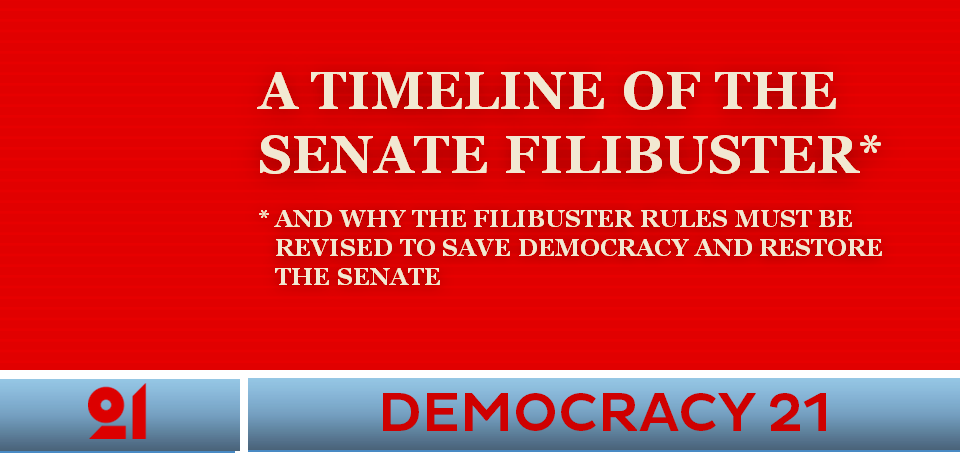

By: Fred Wertheimer, President, Democracy 21 | December 2021
The United States Senate is facing a decision of historic consequence with the fate of our democracy at stake.
Will 50 Senators plus the Vice President be able to pass the Freedom to Vote Act and override a wave of new state voter suppression laws that threaten the ability of millions of Americans to vote in federal elections?
Will they be able to pass the Act and prevent new state election subversion laws from empowering partisan state election officials to rig the outcomes of federal elections?
Will the filibuster rules be changed to allow the Freedom to Vote Act and the John Lewis Voting Rights Advancement Act to pass the Senate by a majority vote?
Or, will the Senate filibuster rules be preserved intact, allowing Senators to continue blocking the Senate from acting on these crucial laws?
How these questions are ultimately answered could very well determine the fate of our democracy.
The grave risk facing our democracy today stems directly from former President Donald Trump’s Big Lie that the 2020 presidential election was stolen from him – pure demagoguery repeated incessantly and with no basis in fact.
The Freedom to Vote Act and the John Lewis Voting Rights Advancement Act would override the state voter suppression laws triggered by Trump’s Big Lie. They would also protect against partisan election administration officials rigging the results of federal elections and protect against future enactment of state and local voter discrimination laws.
Standing in the way of enacting these bills are the Senate filibuster rules, which need to be revised. In that context, we examine a Senate timeline of the filibuster rules.
The Senate filibuster was created by mistake in 1806.
In the 205 years since then, the filibuster has repeatedly been used to block a wide swath of civil rights protections – from anti-lynching laws and anti-poll tax measures in the 19th and 20th centuries to the efforts today to block voting rights protections.
Our timeline shows that the Senate filibuster rules were never written in stone. They have been routinely changed.
For example, during the period from 1969 to 2014, the filibuster rules were bypassed 161 times when specific measures were allowed to pass the Senate by majority vote without being subject to the filibuster rules.
Senator Robert C. Byrd (D-WV), the acknowledged master of the Senate Rules, always opposed eliminating the filibuster rules entirely, but he also believed that the filibuster rules should be changed when “circumstances change.”
Senator Byrd played a pivotal role in changing the filibuster rules twice in the 1970s.
Byrd also played the pivotal role in creating the budget reconciliation process in the 1970s which, to this day, allows massive federal budgets to be passed in the Senate by a majority vote.
Our timeline also spotlights the greatest abuser of the filibuster – Senator Mitch McConnell (R-KY).
Senate Republican Leader McConnell dramatically changed the character and role of the filibuster and the circumstances in which it is used. Senator McConnell turned the filibuster rules from a process for protecting the rights of the Senate minority into a political weapon used repeatedly for partisan, not policy, reasons during the Obama and Biden presidencies.
The weaponizing of the filibuster by Senator McConnell and his Republican colleagues has made the Senate a dysfunctional and often paralyzed institution. This is exactly the kind of “changed circumstance” that Senator Byrd recognized requires the filibuster rules to change.
The attacks this year on the right to vote and the integrity of our elections have put our democracy at grave risk. The need to revise the filibuster rules is of paramount importance.
For the Senate to save our democracy and to be known again as the “world’s greatest deliberative body,” the Senate filibuster rules must be revised. The Freedom to Vote Act and the John Lewis Voting Rights Advancement Act must be enacted to protect our nation.

“[W]hen we dig into the history of Congress, it seems that the filibuster was created by mistake.” – Political Science Professor Sarah A. Binder.[1]

Vice President Aaron Burr – Public Domain
1806 – At the suggestion of Vice President Aaron Burr, the Senate ends its use of the “previous question motion” which empowers a simple majority to end debate on a measure. Vice President Burr’s suggestion was simply to clean up the Senate rule book which included rules Burr considered unnecessary.[2]
Political Science Professor Sarah Binder: The rule’s elimination was “[n]ot because Senators in 1806 sought to protect minority rights and extended debate. They got rid of the rule by mistake: Because Aaron Burr told them to.”[3]
1837 – A minority of Senators opposing President Andrew Jackson conduct the first filibuster in an unsuccessful effort to prevent Jackson’s allies from expunging a resolution of censure against him.[4]
1800s – The Senate filibuster is rarely used in the 1800s, the Brennan Center notes, “as it required Senators to physically stay on the Senate floor and continue their speechmaking, a tactic difficult to sustain for any great length of time. Its impact was therefore limited, perhaps causing some delays but not derailing legislation opposed by the filibustering Senators — which might explain why ‘almost every filibustered measure before 1880 was eventually passed.’”[5]
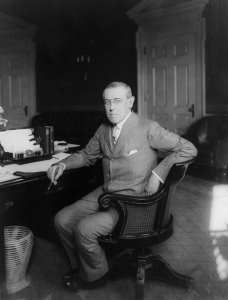
President Woodrow Wilson in the Oval Office, circa 1913. – Public Domain
1917 – Following a successful filibuster of legislation to arm merchant ships as a means to protect against German attack, which isolationist Senators feared would lead the country into World War I, President Woodrow Wilson demands that the Senate adopt a rule to prevent a “little group of willful men, representing no opinion but their own” from blocking future legislation.[6]
President Wilson laments that the U.S. Senate “is the only legislative body in the world which cannot act when its majority is ready for action.”[7]
That spring, the Senate adopts a “cloture” rule to allow a super-majority vote of two-thirds of Senators to cut off a debate.
However, even with the new cloture rule, the Senate Historical Office notes, “filibusters remained an effective means to block legislation, since a two-thirds vote was difficult to obtain. Over the next four decades, the Senate managed to invoke cloture only five times. Filibusters proved to be particularly useful to southern Senators who sought to block civil rights legislation, including anti-lynching bills.”[8]
Of measures derailed by filibusters in the 20th century, civil rights measures are the leading victims.
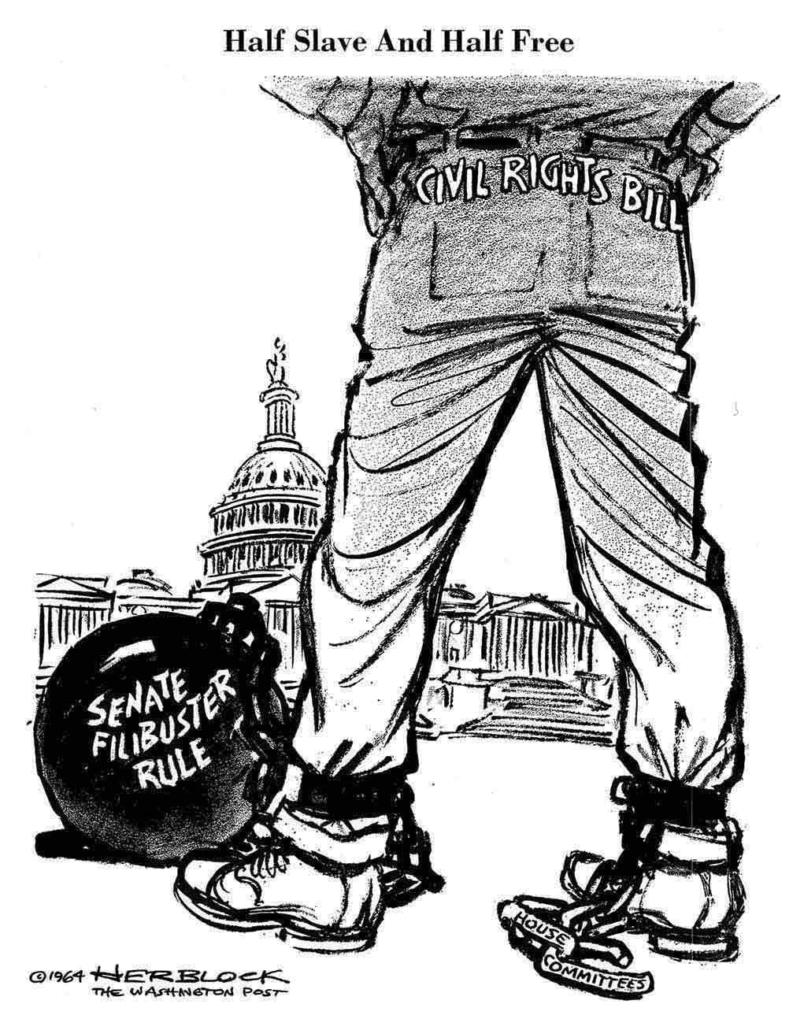
1964 Herblock Cartoon, courtesy of © The Herb Block Foundation
Professor Binder: “Of the 30 measures we identified between 1917 and 1994, exactly half addressed civil rights – including measures to authorize federal investigation and prosecution of lynching, to ban the imposition of poll taxes, and to prohibit discrimination on the basis of race in housing sales and rentals. Keep in mind, the 20th century filibuster [also] scorched many civil rights measures beyond those that it killed outright.”[9]
These anti-civil rights filibusters were often defended, according to the Center for American Progress, “with ‘inflated rhetoric about an alleged Senate tradition of respecting minority rights and the value of extended debate on issues of great importance.’ But belying this rhetoric, conservatives during this period generally refrained from engaging in filibusters on issues other than civil rights.”[10]
1957 – On August 28-29, South Carolina Senator Strom Thurmond conducts a record 24-hour, 18-minute filibuster of the Civil Rights Act of 1957 legislation.[11] The legislation is ultimately passed after it is significantly modified and basic provisions are removed.[12]
1964 – Multiple southern Senators conduct a 60-day filibuster of the Civil Rights Act of 1964. The filibuster is ended by a successful cloture vote on June 10.[13]
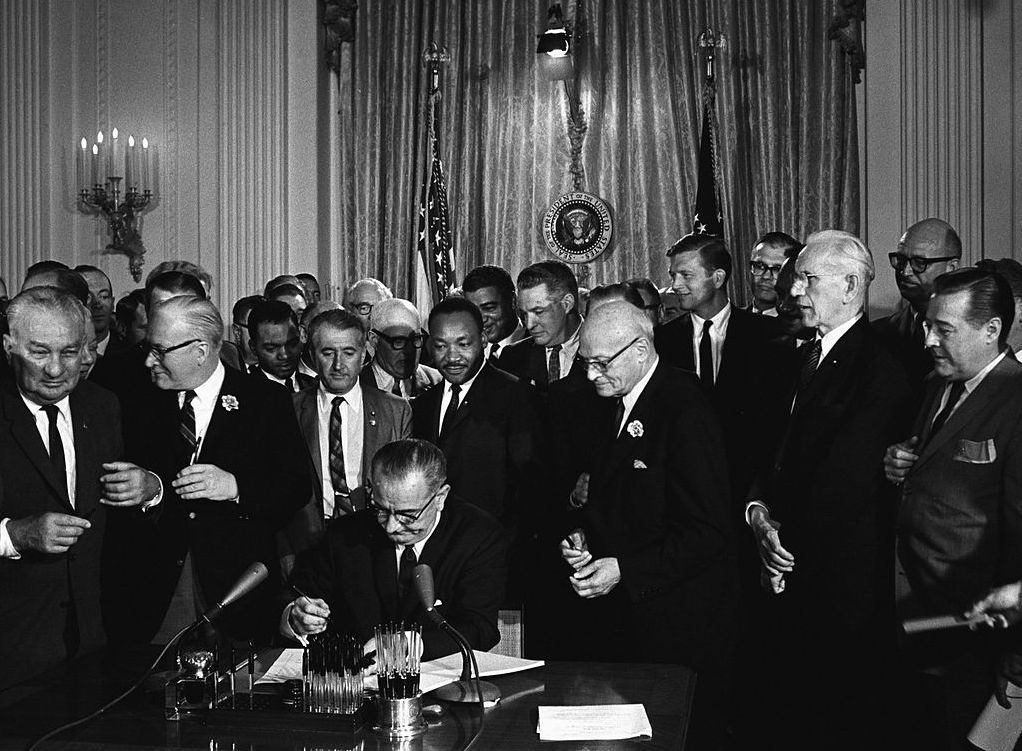
President Lyndon Johnson signs the Civil Rights Act of 1964 into law. – White House Press Office/Public Domain
Before the Civil Rights Act of 1964, never in history had the Senate been able to muster the votes needed to cut off a filibuster on a major civil rights bill.[14]
1974 – Senator Robert C. Byrd (D-WV) plays a lead role in the creation of the budget reconciliation process, a massive, ongoing exception to the filibuster rules.[15]
1975 – Senator Byrd plays a lead role in changing the filibuster rules.[16] Senators reduce the number of votes needed for cloture from 67 votes (two-thirds of Senators) to 60 votes (three-fifths of Senators).[17]
Brennan Center: “Undercutting this reform, however, the Senate contemporaneously adopted a rule that gave the filibuster new strength. No longer would a filibuster delay all Senate business. Instead, new Senate procedure would create a dual-tracking system that allowed the body to toggle between different bills so that a bill facing a filibuster was ‘kept on the back burner’ until a vote for cloture could be successful. […] The talking filibuster had died.”[18]
“I say to you that certain rules that were necessary in the 19th century, and in the early decades of this century, must be changed to reflect changed circumstances.” — Senator Robert C. Byrd (D-WV), supporting a change to the filibuster rules in 1979[19]
1979 – Senator Byrd leads a successful effort to change the filibuster rules by eliminating post-cloture filibusters.[20]
Since the 1970s, the use of the filibuster has mushroomed.
The Brennan Center: The use of the filibuster has “become the normal practice of the Senate, not the exception.”[21] As the use of the filibuster has mushroomed, so has the number of exceptions to the filibuster rules.
Between 1969 and 2014, there have been 161 exceptions to the Senate filibuster rules’ supermajority requirement. The exceptions cover a wide range of policy areas, including trade, foreign policy, defense, the budget, and health care.[22]
1985 – Senator Byrd leads an unsuccessful effort to change the filibuster rules, proposing changing the number of votes needed for cloture to end a filibuster from 60 Senators to three-fifths of Senators present and voting.[23]
1985: The McConnell Era Begins – Senator Mitch McConnell (R-KY), elected to the Senate in 1984, becomes, in time, the king of obstructionist filibusters. Professors Jacob Hacker and Paul Pierson : “No one presently — or perhaps ever — in the Senate has practiced the dark art of obstruction as relentlessly as Mitch McConnell.”[24]
2009-2016 – During the Obama Administration, Senate Republicans, under Senator McConnell, use the filibuster more than ever in history.[25]
2010 – Senator McConnell: “The single most important thing we want to achieve is for President Obama to be a one-term president.”[26]
From 2009 through 2014, there are a historic 382 cloture votes held in the Senate.[27] Fully half of the 168 Senate filibusters of executive and judicial nominees in American history come during the first five years of the Obama Administration, when McConnell is minority leader.[28]
“When McConnell leaves the Senate, this will be his legacy: Senator McConnell turned the world’s greatest deliberative body into a dysfunctional, undemocratic, and feckless institution.” – Fred Wertheimer, Democracy 21[29]
Brennan Center: “Cloture motions have skyrocketed since 2006, doubling from that year to the next and reaching an all-time high in the [2019-2020] Senate. There have been as many cloture motions in the last 10 years (959) as there were during the 60-year period from 1947 to 2006 (960).”[30]
2011 – Senator Joe Manchin (D-WV), the successor to and admirer of Senator Byrd[31], cosponsors and votes for two measures to change the filibuster rules: S. Res. 10, to eliminate the filibuster on motions to begin debate on legislation, and S. Res. 21, to revise filibuster rules to require Senators to actually take the floor and filibuster by making remarks. Both ultimately fail.[32]
In supporting the resolutions, Senator Manchin says: “West Virginians deserve a government that works for them, and they are understandably frustrated with the way things get done – or don’t – in Washington.”[33]
“Unfortunately, the legislative process in Washington has gotten so dysfunctional that it doesn’t even make much sense at all anymore. … We have become paralyzed by the filibuster and an unwillingness to work together at all.” – Senator Joe Manchin (D-WV), in 2011[34]
2013 – After Senator McConnell uses an unprecedented number of filibusters to prevent the confirmation of Obama nominees, the Senate uses the “nuclear option” to eliminate filibusters for most presidential nominations.[35]
Senate Majority Leader Harry Reid (D-NV) says: “The American people believe the Senate is broken, and I believe the American people are right. It’s time to get the Senate working again.”[36]
2017 – Senator McConnell, now Majority Leader, leads his own successful effort to bypass the filibuster rules by invoking the “nuclear option” to allow a majority of Senators, instead of 60, to end a filibuster on Supreme Court nominees. [37]
The Senate proceeds to confirm three Trump-nominated Supreme Court Justices by majority vote, under this exception to the filibuster rules. None receives 60 votes.[38]
The two most substantial legislative actions of the past 12 years — President Obama’s Affordable Care Act and President Trump’s tax cuts — were achieved only because one party used an exception to the filibuster rules.[39]

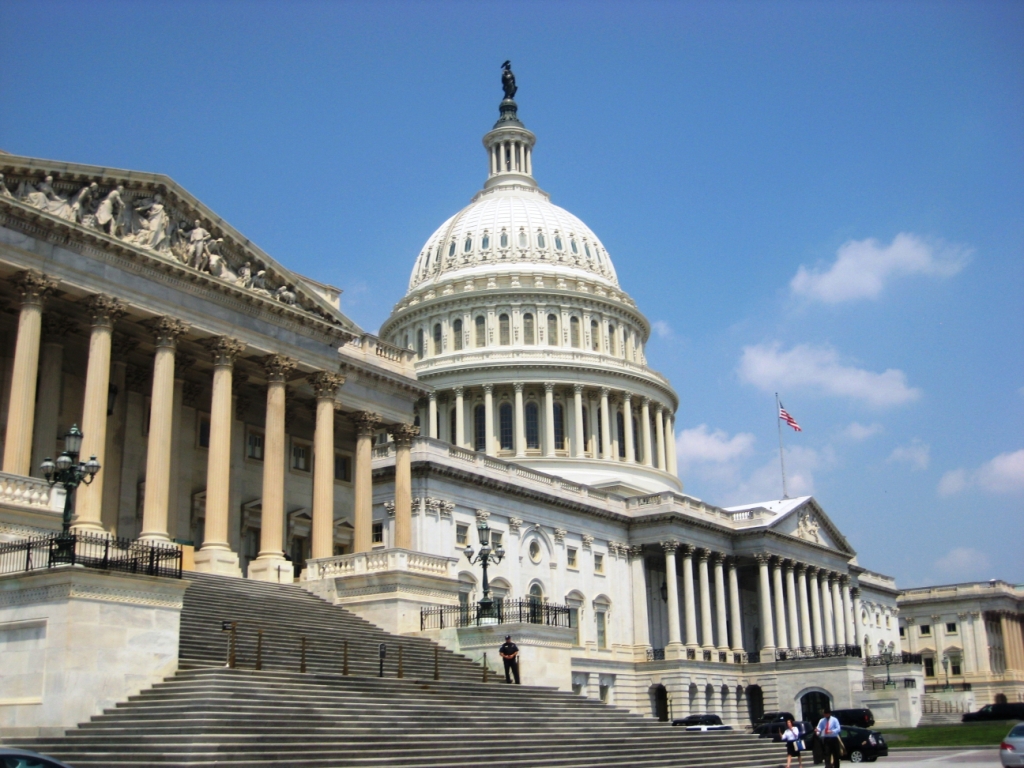
U.S. Capitol – USGS/Public Domain
Senate Minority Leader McConnell: “One-hundred percent of our focus is on stopping this new Administration.”[40]
Today, nearly every part of President Joe Biden’s agenda, including voting rights, immigration reform, and lowering prescription drug prices faces Republican filibusters, unless they can be included in reconciliation bills which can be passed by majority vote. Even the bipartisan plan to establish an independent commission to investigate the January 6 attack on the Capitol is blocked by a Republican filibuster.[41]
Senator McConnell’s obstructionism extends to the debt ceiling, where his threat of a Republican filibuster in the fall brings the nation to the brink of defaulting on its debt for the first time in history.[42] Senator Chris Van Hollen (D-MD): “McConnell is singularly focused on winning control of the Senate in the 2022 midterm elections, full stop. To his mind, that means using every tactic at his disposal to cause President Biden to fail, even if that hurts the country.”[43]
“The role of the filibuster has fundamentally changed over the years from a stated purpose to protect the interests of the Senate minority into a powerful weapon for the minority to control the majority and paralyze the Senate.” – Fred Wertheimer and Norman Eisen[44]
March 2021 – H.R. 1, the For the People Act – sweeping voting rights and campaign finance reform legislation – passes in the House on March 3 and moves to the Senate for consideration.[45] The For the People Act would override the wave of voter suppression laws passed in 2021 by Republican-controlled legislatures in 19 states. These voter suppression laws are aimed in particular at preventing voting by Black, brown, and other minorities.[46]
The voter suppression laws, The Washington Post notes “could strain every available method of voting for tens of millions of Americans, potentially amounting to the most sweeping contraction of ballot access in the United States since the end of Reconstruction, when Southern states curtailed the voting rights of formerly enslaved Black men.”[47]
March 23, 2021 – Senator McConnell on the filibuster: “It has no racial history at all. None.”[48]
Professor Binder: “That’s false. Historians know the filibuster is closely intertwined with the nation’s racial past and present. To be sure, Senators have filibustered issues other than civil rights over the Senate’s history. But it is impossible to write that history without recognizing the centrality of race.”[49]
April 28, 2021 – On the “sacred issue of voting rights,” Senate Majority Leader Chuck Schumer (D-NY) says, “failure is not an option.”[50]
May 17, 2021 – Senator Manchin says of voting rights legislation, “Inaction is not an option.”[51]
June 22, 2021 – Republicans use the filibuster to block debate on H.R. 1 / S. 1, the For the People Act.[52]
August 11, 2021 – Republicans again use the filibuster to block debate on H.R. 1 / S. 1, the For the People Act. Senate Majority Leader Schumer: “Republicans have formed a wall, a total wall of opposition against progress on voting rights in the United States Senate. Even on an issue as sacred as the right to vote, Senate Republicans refuse to allow even a debate.”[53]
October 20, 2021 – Republicans again use the filibuster, this time to block debate on the Freedom to Vote Act, compromise legislation crafted by Senator Manchin.[54]
The Freedom to Vote Act and the John Lewis Voting Rights Advancement Act are considered essential to protect the sacred right to vote from state voter suppression and discrimination laws enacted in state legislatures in 2021, and to prevent the subversion and rigging of federal elections by partisan Republican election officials.
Senators Manchin and Kyrsten Sinema (D-AZ) are the two Democratic holdouts, to date, to creating a change in the filibuster rules that will allow these essential democracy reforms to pass by majority vote.[55]
Washington Post columnist E.J. Dionne Jr.: Will Senators Manchin and Sinema “stick with their refusal to alter the filibuster and thus make themselves complicit in the death of a bill as important to democracy in our times as the original Voting Rights Act was in 1965?”[56]
“Without bypassing the filibuster rules, as has been routinely done in the past, voting rights legislation will die in the Senate.” – Fred Wertheimer[57]
October 21, 2021 – In a Town Hall event, President Biden says that activists seeking a filibuster rules change to pass the voting rights measures by majority vote “make a very good point. … We’re going to have to move to the point where we fundamentally alter the filibuster.”[58]
October 24, 2021 – In an interview on CNN, House Speaker Nancy Pelosi (D-CA) says: “The most important vote right now in the Congress of the United States is the vote to respect the sanctity of the vote, the fundamental basis of our democracy. So, if there were one vote that the filibuster could enable to go forward that would be the vote.”[59]
November 3, 2021 – Republicans use the filibuster to block debate on the John Lewis Voting Rights Advancement Act, marking the fourth time in 2021 that a Republican-led obstructionist filibuster has blocked consideration of a voting rights measure.[60]
Republican Senator Lisa Murkowski (R-AK) is the only Republican to vote to end the filibuster and allow debate on the measure.[61]
In the four cloture votes on voting rights legislation in 2021, that is the single time that a Republican votes for cloture to allow debate on a voting rights measure.[62]
“What started out as an unusual practice to extend debate has become a routine method for blocking the will of the majority. To put it starkly: Abuse of the filibuster is wrecking the Senate.” – E.J. Dionne Jr.[63]
“To lose our democracy but preserve the filibuster in its current form — in which a minority can block popular legislation without even having to hold the floor — would be a short-sighted blunder that future historians will forever puzzle over.” – Statement of 154 Democracy Scholars in support of the Freedom to Vote Act[64]
Also from Democracy 21: Analysis: Why The Filibuster Rules Must Be Revised In Order To Protect Voting Rights And Save The Senate.
For more information visit: www.democracy21.org
END NOTES
[1] Senate Rules Committee, U.S. Senate (4/22/2010)
[2] Senate Rules Committee, U.S. Senate (4/22/2010)
[3] Senate Rules Committee, U.S. Senate (4/22/2010)
[4] Senate Reverses A Presidential Censure, Senate Historical Office, U.S. Senate
[5] The Case Against The Filibuster, Brennan Center for Justice (2020)
[6] Cloture Rule, Senate Historical Office, U.S. Senate
[7] Cloture Rule, Senate Historical Office, U.S. Senate
[8] About Filibusters and Cloture | Historical Overview, Senate Historical Office, U.S. Senate
[9] Mitch McConnell is wrong. Here’s the filibuster’s ‘racial history,’ Sarah Binder, The Washington Post (3/24/2021)
[10] The Impact of the Filibuster on Federal Policymaking, Center for American Progress (12/5/2019)
[11] Congressional Record, (8/22/1957 – 8/30/1957)
[12] Congress Approves Civil Rights Act of 1957, CQ Almanac 1957
[13] Civil Rights Filibuster Ended, Senate Historical Office, U.S. Senate
[14] Civil Rights Filibuster Ended, Senate Historical Office, U.S. Senate
[15] History of Senate Budget Committee, 1974-2006, Senate Budget Committee, U.S. Senate, p. 35 (2006)
[16] Changing the Senate Cloture Rule at the Start of a New Congress, Congressional Research Service (12/12/2016)
[17] Cloture, Senate Historical Office, U.S. Senate
[18] The Case Against The Filibuster, Brennan Center for Justice (2020)
[19] Congressional Record (1/15/1979)
[20] Senate Cloture Rule, Senate Rules Committee/Congressional Research Service (2011)
[21] The Case Against The Filibuster, Brennan Center for Justice (2020)
[22] Exceptions To The Rules: The Politics of Filibuster Limitations in the U.S. Senate, Molly E. Reynolds, Brookings (7/18/2017)
[23] Senate Cloture Rule, Senate Rules Committee/Congressional Research Service (2011)
[24] Why McConnell Gets Away With Filibustering, Jacob S. Hacker, Paul Pierson, The Atlantic (3/21/2021)
[25] The Case Against The Filibuster, Brennan Center for Justice (2020)
[26] The GOP’s no-compromise pledge, Politico (10/28/2010)
[27] Doctor No: Senator McConnell, the Supreme Court And a 30-Year Career of Obstructionism, Fred Wertheimer, HuffPost (3/15/2016)
[28] Why Harry Reid Went Nuclear, The Atlantic (11/21/2013)
[29] The Man Who Ruined The Senate: Meet Mitch McConnell, Fred Wertheimer, Medium (6/26/2019)
[30] The Case Against The Filibuster, Brennan Center for Justice (2020)
[31] Manchin Statement On One Year Anniversary Of Robert C. Byrd’s Death, Senator Joe Manchin website (6/28/2011)
[32] West Virginians Deserve A Government That Works For Them, Senator Joe Manchin website (1/27/2011)
[33] West Virginians Deserve A Government That Works For Them, Senator Joe Manchin website (1/27/2011)
[34] Filibuster Frustrates Manchin, Charleston Daily Mail (10/13/2011)
[35] Reid, Democrats Trigger ‘Nuclear’ Option; Eliminate Most Filibusters On Nominees, The Washington Post (11/21/2013)
[36] Reid, Democrats Trigger ‘Nuclear’ Option; Eliminate Most Filibusters On Nominees, The Washington Post (11/21/2013)
[37] Senate Pulls ‘Nuclear Trigger’ To Ease Gorsuch Confirmation, National Public Radio (4/6/2017)
[38] Confirmation of Neil Gorsuch, 54-45, Senate Roll Call Vote (4/7/2017); Confirmation of Brett Kavanaugh, 50-48, Senate Roll Call Vote (10/6/2018); Confirmation of Amy Coney Barrett, 51-48, Senate Roll Call Vote (10/25/2020).
[39] Why Washington Gets So Little Done, CNN (6/2/2021)
[40] McConnell says he’s ‘100 percent’ focused on ‘stopping’ Biden’s administration, NBC News (5/5/2021)
[41] Why Washington Gets So Little Done, CNN (6/2/2021)
[42] The Government Is On Track To Default For The First Time Ever, The Washington Post (10/6/2021)
[43] As The U.S. Hurtles Toward A Debt Crisis, What Does McConnell Want? The New York Times (10/12/2021)
[44] Two People Could Save US Democracy, Wertheimer/Eisen op-ed, CNN (10/20/2021)
[45] House Democrats Pass Sweeping Elections Bill As GOP Legislatures Push To Restrict Voting, The Washington Post (3/3/2021)
[46] Voting Laws Roundup, Brennan Center for Justice (10/2021)
[47] How GOP-Backed Voting Measures Could Create Hurdles For Tens Of Millions Of Voters, The Washington Post (3/11/2021)
[48] McConnell Defends Senate Filibuster: ‘It Has No Racial History At All’, Bloomberg Quicktake Now (3/23/2021)
[49] Mitch McConnell is wrong. Here’s the filibuster’s ‘racial history,’ Sarah Binder, The Washington Post (3/24/2021)
[50] How Chuck Schumer Plans To Pass Voting Rights, MSNBC (4/28/2021)
[51] Senator Joe Manchin, Twitter (5/17/2021)
[52] GOP filibuster blocks Democrats’ big voting rights bill, Associated Press (6/22/2021)
[53] Republicans Again Block Action On Voting Rights And Gerrymandering, HuffPost (8/11/2021)
[54] Senate Republicans Block Voting Rights Bill, Leaving Its Fate in Doubt, The New York Times (10/20/2021)
[55] Senate Republicans again block key voting rights bill, The Guardian (11/3/2021)
[56] A Make-Or-Break Moment For Our Democracy, E.J. Dionne Jr., The Washington Post (9/12/2021)
[57] As It Was In 1965, Today We Cannot Rest. We Must Protect The Sacred Right To Vote, Fred Wertheimer, Medium (8/27/2021)
[58] Biden Is Open to Scrapping Filibuster for Voting Rights Bill ‘and Maybe More’, The New York Times (10/21/2021)
[59] Transcript of Pelosi Interview on CNN‘s “State of the Union With Jake Tapper”, Nancy Pelosi, Speaker of the House (10/24/2021)
[60] Senate Dems push new voting bill, and again hit GOP wall, Associated Press (11/3/2021)
[61] Senate Republicans block debate on a third major voting rights bill, The Washington Post (11/3/2021)
[62] Why The Filibuster Rules Must Be Revised In Order To Protect Voting Rights And Save The Senate, Democracy 21 (11/17/2021)
[63] The hypocrisy argument on the filibuster is itself phony, E. J. Dionne Jr., The Washington Post (11/28/2021)
[64] Statement in Support of the Freedom to Vote Act, (11/2021)
